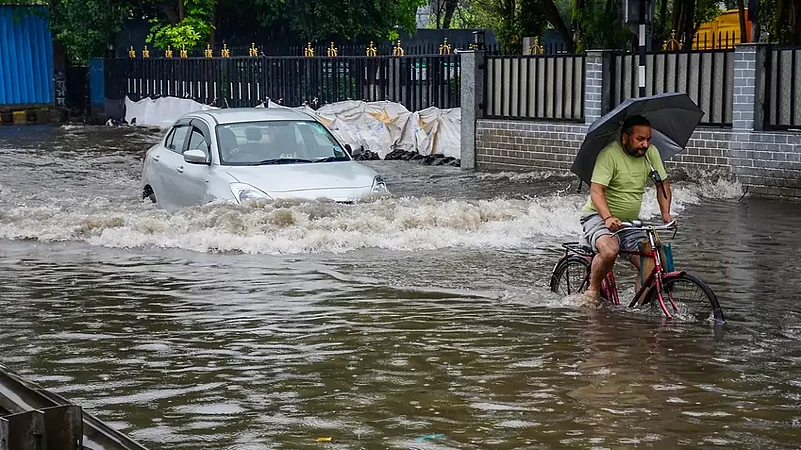Gurugram, the bustling city located on the outskirts of Delhi, India’s capital, has become a symbol of progress and modernity for its rapid development and thriving corporate culture. However, behind the glitz and glamour of the city lies a persistent problem that haunts it every monsoon season – severe flooding. When the rains arrive, many lives get disrupted as Gurugram streets drown in the water, highlighting an urgent need for long-term solutions.
Vipul, a food stall owner in Sector 22, expresses his concerns, saying, "As food stall owners, our livelihood depends on daily income. But whenever it rains and causes waterlogging, our income comes to a complete halt. While such incidents may not have been a significant issue if they occurred only once or twice, the unfortunate reality is that this situation repeats every year and lasts for several days."
A digital marketing employee working in one of the offices situated in Udyog Vihar shares his experience, saying, "I work in Udyog Vihar, and it's disheartening to see the area getting waterlogged not only during the monsoon season but even when unexpected rain showers occur. This area is predominantly occupied by offices, and it becomes quite challenging for us to wade through knee-deep water just to reach our workplaces. As a result, we often end up getting late. Unlike some fortunate individuals who can work from home on rainy days, not everyone has that option."
The lives of every citizen get disrupted by Gurugram’s recurrent waterlogging problem and it is not attributed to just one factor but a multitude of contributing factors.
Rapid Urbanisation And Faulty Drainage Systems
The transformation of Gurugram from a rural area to a vibrant urban hub has been remarkable. Gurugram has evolved as a connected city of Delhi due to its extensive urbanisation and infrastructure development. The city has witnessed remarkable growth with multiple high-rise buildings, swanky malls, and expansive road networks.
The urbanisation of Gurugram, or then Gurgaon, began in the 1970s when Maruti Suzuki India Limited established a manufacturing plant and was followed by IT and BPO companies later. In the 2000s, Gurugram’s urbanisation was rapid and by the 2010s Gurugram became one of the most populous cities in India.
But this progress has come at a price. With explosive population and construction, the city's drainage systems have struggled to keep pace. The rapid obstruction of natural drainage channels and the insufficient capacity of existing stormwater drains have resulted in waterlogging and subsequent flooding during heavy downpours. The vast stretches of land that were once able to absorb rainwater have now been replaced by concrete. As a result, the water collected has nowhere to go and ends up flooding the low-lying areas. This has amplified the severity of floods and submerged the city.
On July 4, in Sectors 38 and 48 of Gurugram, an unusual sight unfolded as people were compelled to navigate waterlogged streets using boats. This incident was captured on video and shared extensively among Twitter users. Sadly, instead of showcasing the city's rapid progress and development, Gurugram, which is renowned for its advancements, became the subject of memes and jokes due to the persistent issue of waterlogging.
Inadequate Planning and Poor Design
The rapid growth of Gurugram has outpaced the development of its drainage infrastructure. The city's stormwater drains and sewerage systems were designed to serve only a fraction of the current population. Insufficient capacity, poor maintenance, and improper cleaning contribute to clogged drains, making them ineffective during heavy downpours. The lack of foresight and inadequate consideration of natural water flow patterns have led to unplanned and disorganised construction of buildings, roads, and pavements, often obstructing the natural drainage paths. Consequently, rainwater accumulates on roads and in residential areas, transforming the streets into turbulent rivers, paralysing transportation, and inflicting misery upon the citizens.
During the first week of July, a significant portion of the city, estimated to be around 70%, experienced extensive flooding, with water levels averaging to about three feet.
Numerous houses in Gurugram were also affected as the rainwater made its way indoors. Distressed residents took to social media platforms to express their frustration and placed the responsibility for the situation on the local authority.
The highways that are meant to facilitate smooth transportation, such as the Delhi-Jaipur Expressway (National Highway 48), experienced severe waterlogging, resulting in a 5-kilometer-long traffic jam in Gurugram. The excessive waterlogging also caused vehicles to break down, adding to the chaotic situation. Commuters and pedestrians were compelled to wade through knee-deep water in low-lying areas. Videos circulating on Twitter captured the sight of submerged tires of both four-wheelers and two-wheelers, highlighting the extent of the problem.
Depleted Natural Water Bodies
Historically, Gurugram was once blessed with numerous lakes and water bodies that served as natural reservoirs during heavy rainfall. However, as time passed by, these channels were blocked by unauthorised construction, unchecked industrialisation, and illegal settlements. The absence of these natural reservoirs has added to the flooding situation.
A video went viral on Twitter depicting a distressing incident where a car was swept away by floodwaters. According to news reports, a woman had parked her vehicle on the river bank in Kharak Mangoli while visiting a temple to offer prayers when the water level in the river unexpectedly rose, sweeping her car in a flash flood with her still inside.
Fortunately, some brave local residents acted swiftly amidst the strong current and managed to rescue the woman from the car. They rushed her to a nearby hospital for medical attention.
In another incident, eight individuals who found themselves stranded near the Ghaggar River in Panchkula were successfully rescued by a team of the National Disaster Response Force (NDRF). The rising water level in the river was due to heavy rainfall in its catchment areas.
Climate Change and Extreme Weather Events
Climate change has altered weather patterns worldwide and Gurugram is no exception. The region now witnesses more intense and concentrated rainfall events during the monsoon season. The city's infrastructure, ill-equipped to handle such extremes, buckles under the weight of heavy showers. The phenomenon of urban heat islands, where built-up areas retain and radiate heat, exacerbates the weather system's volatility, leading to localised intense storms and sudden downpours. This changing climate dynamic amplifies the flooding problem in Gurugram making the battle more challenging.
According to India Meteorological Department (IMD), the cumulative rainfall for the monsoon season has now reached 243.2 mm, surpassing the normal of 239.1 mm by 2%. The latest data from the IMD indicates that north India has received an impressive 59% excess rainfall, with 199.7 mm recorded compared to the normal of 125.5 mm.
Lack of Coordination Among Administrations
The responsibility for addressing Gurugram's flooding problem falls on multiple agencies, like the Municipal Corporation, the Haryana Urban Development Authority, and the state government. The absence of a comprehensive approach hinders the identification of problem areas, delaying infrastructure upgrades and exacerbating the city's vulnerability to flooding.
Maintenance of drainage infrastructure, including regular desilting and cleaning of stormwater drains, must be undertaken promptly and efficiently. Failure to do so leads to the accumulation of debris and sediment, further hampering the water flow.
In some instances, construction activities have been carried out in violation of building regulations, leading to the encroachment of natural drains and waterways. It is not solely the responsibility of the government and associated bodies to be blamed for this issue. Citizens themselves have contributed to the havoc of flooding by their actions and choices.
In 2017, an unauthorised residential complex was constructed in Sector 54 of Gurugram, encroaching upon a natural drain. As a consequence, the area experienced flooding during the monsoon season. Similarly, in 2018, a commercial complex was built in Sector 45, adjacent to the banks of the Najafgarh Drain. This construction hindered the natural flow of rainwater, resulting in flooding in the area during the monsoon season.
According to a study conducted by the Gurugram administration and submitted to the National Green Tribunal (NGT), the city has lost an alarming number of water bodies over the past 66 years. Out of the 640 water bodies recorded in 1956, only 251 remain today. In the past, these water bodies, along with numerous nullahs or drains, such as those at Ghata, Nathupur, Chakkarpur, and Jharsa, played a crucial role in rainwater storage and groundwater replenishment. Unfortunately, their significance was largely overlooked in Gurugram's urban development plans, leading to unsustainable urbanisation.
The negative consequences of this unsustainable development are evident in the deteriorating condition of the Badshahpur nullah, the primary stormwater drain. Its carrying capacity has been significantly reduced due to encroachments, resulting in a
backflow of rainwater. Studies have revealed that the width of the drain near Khandsa village is only 10 meters, whereas it is 30 meters elsewhere. This narrow width has contributed to flooding on NH-48 and at Hero Honda Chowk.
Despite the Haryana government's 2016 decision to widen the drain, the situation has not shown any improvement. In an attempt to address the issue, a parallel drain was constructed, but unfortunately, it was not connected to the Badshahpur nullah. Coupled with the non-functioning Bandhwari waste plant and the loss of natural ponds, this has inevitably led to flooding.
According to an officer working in the Municipal Corporation of Gurgaon (MCG), "We are diligently striving to enhance the city's infrastructure through every available means. Our focused efforts include regular sewage cleaning to mitigate waterlogging issues. However, it's important to acknowledge that while we are doing our best as human beings, we are still unable to compete with the forces of nature."
Addressing these issues requires a comprehensive approach involving urban planning reforms, sustainable drainage solutions, ecosystem restoration, climate resilience strategies, and effective governance. Only by recognising and rectifying these challenges, Gurugram can hope to break free from its recurring monsoon flood and ensure a safer and more sustainable future for its residents.
"We are actively involved in the ongoing redevelopment work and carefully evaluating the areas for necessary development measures. Although the process may take time, we are working as fast as we can to make progress. Our focus extends beyond just cleaning sewage; we are also creating enough space for water to flow smoothly. Additionally, we are taking strong actions against illegal constructions to ensure compliance with regulations and create a safer environment for everyone," says Nilesh Verma, an officer working at Haryana Urban Development Authority (HUDA).












.jpg?auto=format%2Ccompress&fit=max&format=webp&w=376&dpr=2.0)













